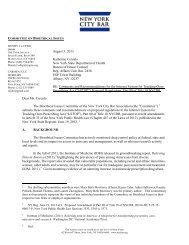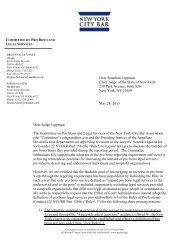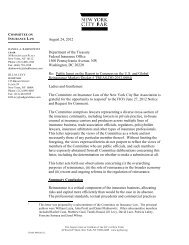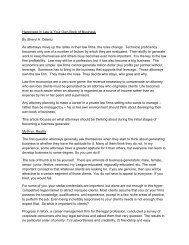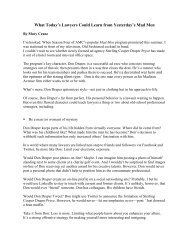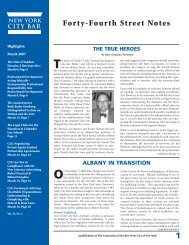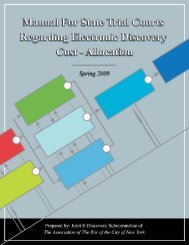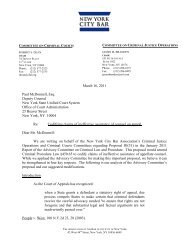2007 Issue 1 - New York City Bar Association
2007 Issue 1 - New York City Bar Association
2007 Issue 1 - New York City Bar Association
You also want an ePaper? Increase the reach of your titles
YUMPU automatically turns print PDFs into web optimized ePapers that Google loves.
P R E V E N T I O N A N D P R O S E C U T I O N O F T E R R O R I S T A C T S<br />
establish jurisdiction over terrorist acts. 28 Two main issues have stalled completion<br />
of the draft: (1) whether acts committed by persons engaged in the struggle<br />
against “foreign occupation” (e.g., Palestinian attacks in Israel) should<br />
be considered acts of terrorism, and (2) whether the acts of states’ armed<br />
forces, which are already subject to the law of armed conflict during wartime,<br />
should be covered by this convention, i.e., whether acts committed<br />
by armed forces may be treated as terrorist acts under this convention. 29<br />
(B) The Definition of Terrorism<br />
The debate over the definition of terrorism, particularly whether the<br />
definition of terrorism should exclude resistance against foreign occupation,<br />
reflects the often-heard adage that one state’s terrorist is another<br />
state’s freedom fighter. It is a tension that has existed since the UN’s first<br />
attempts at addressing terrorism in the early 1970s. 30 At that time, there<br />
was a larger degree of tolerance for the position that politically motivated<br />
acts, particularly those committed in resistance to foreign occupation,<br />
did not constitute terrorism. As Professor Malvina Halberstam observes,<br />
this was demonstrated in a 1972 General Assembly (GA) resolution relating<br />
to terrorism that established an Ad Hoc Committee on Terrorism but<br />
at the same time “reaffirm[ed] the inalienable right to self-determination<br />
and independence of all peoples under colonial and racist regimes and<br />
other forms of alien domination and uph[eld] the legitimacy of their<br />
struggle, in particular the struggle of national liberation movements.” 31<br />
28. See Report of the Ad Hoc Committee established by General Assembly Resolution 5/210<br />
of 17 December 1996, U.N. GAOR, 57 th Sess., Supp. No. 37, Annexes I-III, U.N. Doc. A/57/<br />
37 (2002).<br />
29. See Measures to eliminate international terrorism: Report of the Working Group, U.N.<br />
GAOR 6 th Comm., 59 th Sess., Annex, Agenda Item 148, p. 4, U.N. Doc. A/C.6/59/L.10 (2004).<br />
See also Jim Wurst, U.N. Deadlock Continues on Two Terrorism Treaties, U.N. WIRE, Dec.<br />
10, 2003; Jim Wurst, Negotiations on Anti-Terrorism Treaties Yield No Progress, U.N. WIRE,<br />
February 4, 2002. Like the definition of terrorism, this issue of whether armed forces should<br />
be covered is closely related to the Israeli-Palestinian conflict. The Organization of the Islamic<br />
Conference has urged that any exclusion from the treaty’s provisions for the actions of armed<br />
forces should also cover situations of foreign occupation.<br />
30. The goal of achieving a universal definition of terrorism dates back to the League of<br />
Nations. The Convention for the Prevention and Punishment of Terrorism included a definition<br />
of terrorism, but the treaty never entered into force. See Alex Schmidt, War Crimes<br />
Research Symposium: “Terrorism on Trial”: Terrorism—The Definitional Problem, 37 CASE<br />
W. RES. J. INT’L L. 375, 385 (2005). The UN resumed the attempt to reach a definition after the<br />
terrorist attacks at the 1972 Munich Olympics. Id. at 386.<br />
31. See G.A. Res. 27/3034, U.N. GAOR, 27th Sess., Supp. No. 30, at 119, U.N. Doc. A/RES/<br />
2 0 0 7 V O L. 6 2 , N O. 1<br />
31



